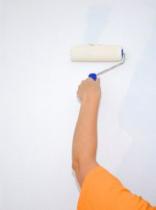Preparing the Ground for Paving
This is an area that people often neglect, so well worth chatting about here.
Before starting, you absolutely must make sure that you are not working over the top of pipes or other utilities.
It is also a good idea to start the work on a day when the ground is ‘damp’ - not wet, just not too dry.
Next make sure that the area has a slope for drainage (around 6mm per 300mm), sloping away from any other structures.
Now mark out the area with wooden stakes and string, so you can clearly see the area to be prepared.
Next you need to get rid of enough dirt/topsoil to allow you to lay the gravel base. This is where you really need to buy or hire something to really get the soil flat and stable enough for the stone to be laid in it. A good plate compactor will save you a lot of time and energy here, other wise it will take you for ever.
Once you have levelled and compacted the soil, you can dump your gravel/stone in place and spread it evenly. Again, the plate compactor will help enormously here. This task is crucial - do not rush it.
Once you have a good level surface, you can then start to lay your paving.
If demand is high, I will do a more detailed advice on the actual paving itself.
Give Your Kitchen a Facelift - the Economical Way!
 Think you need a new kitchen? … or more importantly. does your Wife think you need one?
Think you need a new kitchen? … or more importantly. does your Wife think you need one?
Want to save money when doing it ? … of course you do :)
Then do it the easy way - with Paint! … and a bit of common sense.
Painting your kitchen is probably the most inexpensive way you can upgrade your house. By painting your walls a new color or by simply repainting them with the same color, your kitchen will have a completely new look. A recently painted kitchen is an interesting new chapter in your home.
The secrets in achieving your expected end result, are in purchasing the right products to start with, and then cleaning the wall and the countertops completely before painting them. An oil based primer will allow the paint to stick better as well as hide any left shades on the countertops and walls so that they don’t show through the paint.
After cleaning the surfaces for painting, they are now prepared for the primer coat. Do not forget the primer coat must be dried completely before proceeding on the next step. If it has dried, you can now apply the first coat which mostly dries out within an hour, after which you can put in one more coat and the next coats as well.
There are three kinds of paint you can select from: latex, epoxy, and oil. Latex is the most economical yet it will mostly call for a new painting job once every two to five years dependent on the abrasion you put on it. Latex will create a flat color but a clean polish. Oil, on the other hand, is slightly more costly than latex but it can reduce water damage. Epoxy is the most costly of the three kinds of paint yet it is also the most hard-wearing, as well as it will give your kitchen a polished look.
If you have a Victorian kitchen, you can repaint it in identical traditional colors. Just don’t forget to match the shades with the theme of your kitchen. You can choose vintage blues, greens, and reds for the country style and grays, beiges, or shades of taupes for the modern touch.
It is well worth a try - and even if you get it wrong, well, you are no worse off cos you needed a new kitchen anyway, right ?